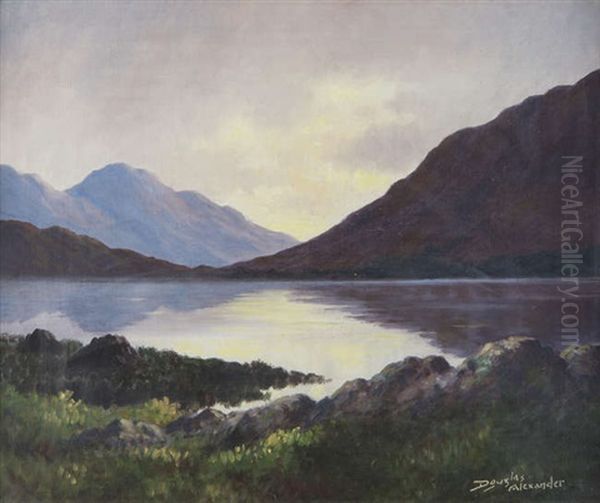
Douglas Alexander (1871-1945) stands as a notable figure in Irish art history, particularly recognized for his evocative depictions of the landscapes of Western Ireland. Working primarily in oils and watercolors, Alexander dedicated much of his artistic career to capturing the unique atmosphere, light, and rugged beauty of the Connemara region. Though perhaps not as internationally renowned as some of his contemporaries, his work holds a significant place within the tradition of Irish landscape painting and continues to be appreciated by collectors and enthusiasts of Irish art. His life, rooted in Limerick but artistically focused on the West, provides a glimpse into the world of an artist deeply connected to his native land.
Early Life and Limerick Roots
Born in Limerick, Ireland, in 1871, Douglas Alexander hailed from a well-regarded local Quaker family. His father, Samuel Alexander, was a businessman in the city, suggesting a background of relative stability and community standing. The Quaker community in Ireland, though small, often played a significant role in commerce and social life, and the Alexander family appears to have been part of this fabric in Limerick. This upbringing likely provided a foundation, though specific details about his early childhood influences remain scarce.
Regarding his formal education, records indicate that Douglas Alexander spent time in his youth as an apprentice at J&G Boyd, a wholesale business. This practical, commercial training contrasts with the path often taken by aspiring artists who might attend formal art academies. There is no clear evidence or documentation suggesting that Alexander received formal higher education or specific, institutional art training. This implies he may have been largely self-taught or perhaps received informal instruction, developing his skills through practice and observation – a path not uncommon for artists of his era.
Artistic Focus: The Lure of Connemara

The defining characteristic of Douglas Alexander's artistic output is his profound connection to the landscapes of Connemara in the West of Ireland. This region, known for its dramatic mountain ranges (like the Twelve Bens, also known as the Twelve Pins), expansive bogs, intricate coastline, and ever-changing light, has long captivated artists. Alexander was clearly drawn to its unique character, returning to it repeatedly as the central subject of his work. His paintings explore the interplay of light and shadow across the mountains, the reflective surfaces of its loughs (lakes), and the textures of its wild terrain.
His dedication to Connemara suggests a deep appreciation for the raw, untamed beauty of the Irish landscape. Whether working in oil or watercolor, Alexander sought to translate the specific atmosphere of the region onto canvas or paper. His choice of subject aligns him with a strong tradition in Irish art, where the landscape is often imbued with cultural and emotional significance. Artists like Alexander played a role in shaping the visual identity of Ireland, particularly the West, presenting its distinct features to a wider audience.
Style and Technique
Douglas Alexander developed a style characterized by careful observation and a sensitivity to the nuances of the natural world. His works, particularly his landscapes, are often noted for their detailed rendering and the skillful capture of light and atmospheric effects. He paid close attention to the way light falls on the mountains or reflects in the water, elements crucial to conveying the mood of the Connemara landscape, which can shift dramatically with the weather.
His proficiency extended to both oil painting and watercolor. Oils allowed him to build up texture and depth, capturing the solidity of the mountains and the richness of the scenery. Watercolors, on the other hand, lent themselves to capturing the transient effects of light and weather, the fluidity of water, and the softness of the Irish skies. His ability to work effectively in both mediums demonstrates a versatile technical skill. Beyond technical proficiency, his works are often described as possessing an emotional resonance, conveying a sense of place that goes beyond mere topographical accuracy.
Notable Works and Portraiture
Several specific works by Douglas Alexander are known, often appearing in auction records and collections, highlighting his focus on the Connemara region. Among these are:
Evening, Kylemore, Connemara: An oil painting capturing the serene beauty of the Kylemore area, likely focusing on the famous abbey or lough in the evening light. Its recorded sale price indicates a solid appreciation for his work in the art market.

A Mounting of the Twelve Pins, Connemara: This watercolor specifically references the iconic mountain range, suggesting a focus on the dramatic topography of the region. The medium of watercolor would be well-suited to capturing the atmospheric conditions around the peaks.
Reflections, Connemara: An oil painting whose title emphasizes Alexander's interest in the interplay of light and water, a common feature in the lake-dotted landscape of Connemara. This work achieved a notable price at auction, reflecting its appeal.
Evening Reflections, Connemara: Possibly related to the work above, this title again underscores his fascination with the effects of light, particularly during the evocative evening hours, on the Connemara waters.
While primarily known as a landscape painter, Alexander also engaged in portraiture. Significantly, he is known to have painted a portrait of Michael Collins, the influential Irish revolutionary leader, soldier, and politician. This indicates Alexander's engagement with the significant figures and turbulent history of his time, extending his artistic scope beyond pure landscape. Painting such a prominent figure suggests a degree of recognition and connection within Irish society.
Exhibitions and Recognition
Throughout his career, Douglas Alexander exhibited his work at several key venues in Ireland, which helped to establish his reputation. He showed his paintings at the Goodwin Galleries in his native Limerick and at the prestigious Victor Waddington Galleries in Dublin, a significant hub for Irish art in the 20th century. Furthermore, he regularly submitted works to the annual exhibitions of the Royal Hibernian Academy (RHA), Ireland's premier institution for the visual arts, and the Dublin Sketching Club. Consistent participation in these exhibitions placed his work before the public and his peers, integrating him into the contemporary Irish art scene.
The market for Alexander's work, particularly posthumously, indicates sustained interest. His paintings frequently appear at auction, often fetching prices ranging from hundreds to several thousands of pounds or euros, depending on the size, medium, and quality of the piece. Works like Reflections, Connemara achieving figures around €5,500 demonstrate a strong collector interest in his best pieces. This market recognition, alongside his exhibition history, confirms his status as a respected, albeit perhaps not leading, figure in early 20th-century Irish art.
Context within Irish Art
Douglas Alexander worked during a period of significant activity and evolution in Irish art. The late 19th and early 20th centuries saw a flourishing of landscape painting, often tied to a growing sense of national identity and an appreciation for the unique character of the Irish countryside. Alexander's focus on the West of Ireland places him alongside other prominent artists who were drawn to similar subjects.
Perhaps the most famous interpreter of the West of Ireland landscape during this era was Paul Henry, whose iconic, poster-like depictions of clouds, bogs, and cottages came to define a particular vision of rural Ireland. While Henry's style was often bolder and more stylized, both artists shared a deep engagement with the region. Another major figure was Jack B. Yeats, brother of the poet W.B. Yeats, whose work evolved from illustrative depictions of Irish life to highly expressive, painterly canvases capturing the energy and emotion of his subjects, including landscapes.
Other contemporaries or near-contemporaries exploring Irish landscapes included Nathaniel Hone the Younger, an earlier figure whose atmospheric works influenced later generations, and Walter Osborne, known for his plein-air scenes of rural life and landscapes, often imbued with a gentle realism. Augustus Nicholas Burke was another artist known for his Connemara scenes, working slightly earlier than Alexander. Aloysius O'Kelly also depicted scenes of the West, sometimes with a narrative or social dimension.
Internationally successful Irish artists like the portraitists Sir John Lavery and Sir William Orpen also occasionally turned their attention to Irish landscapes, though their primary reputations lay elsewhere. Roderic O'Conor, who spent much of his career in France and associated with the Pont-Aven school alongside Gauguin, brought a Post-Impressionist sensibility to his work, including some Irish subjects.
Later landscape painters who continued the tradition included popular artists like Frank McKelvey and James Humbert Craig, known for their accessible and widely appreciated views of the Irish countryside. Even figures like George Russell (AE), known for his mystical and literary pursuits, contributed unique, visionary landscapes. The popular songwriter and performer Percy French was also a prolific watercolorist, capturing charming, if less formal, views of Ireland. Alexander's work fits within this broad context as a dedicated and skilled practitioner focused specifically on the Connemara region, contributing his distinct, detailed vision to the rich tapestry of Irish landscape art.
Later Life and Legacy
Despite his family's prominent standing in Limerick and his consistent activity as an artist with recognized market value, the available information suggests that Douglas Alexander faced hardship in his later years. Sources indicate that he died in poverty in 1945. The reasons for this decline in fortune are not detailed, but it presents a poignant contrast between his artistic contributions and his personal circumstances at the end of his life. This situation was not unique among artists, but it adds a layer of complexity to his biography.
Douglas Alexander's legacy lies primarily in his body of work dedicated to the Connemara landscape. Through his detailed and sensitive paintings, he captured a specific vision of this unique part of Ireland, contributing to the artistic record of its natural beauty. His paintings serve as windows into the mountains, loughs, and atmosphere of the region as he experienced it in the early 20th century. His work continues to be sought after by collectors of Irish art, ensuring that his name and contribution are remembered. He remains a respected figure within the specific niche of Irish landscape painting, valued for his technical skill and his evident affection for his chosen subject matter.
Conclusion
Douglas Alexander (1871-1945) was an Irish artist whose life and work were intimately connected with his homeland. Born into a Quaker family in Limerick, he dedicated his artistic practice primarily to capturing the landscapes of Connemara through detailed and atmospheric oil and watercolor paintings. While perhaps lacking formal art academy training, he developed a distinct style appreciated for its sensitivity to light and place. Exhibiting regularly in Ireland and achieving recognition in the art market, his work stands alongside that of contemporaries like Paul Henry and Jack B. Yeats, contributing to the rich tradition of Irish landscape painting. Despite facing personal hardship later in life, his artistic legacy endures through his evocative depictions of the West of Ireland, ensuring his place in the annals of Irish art history.